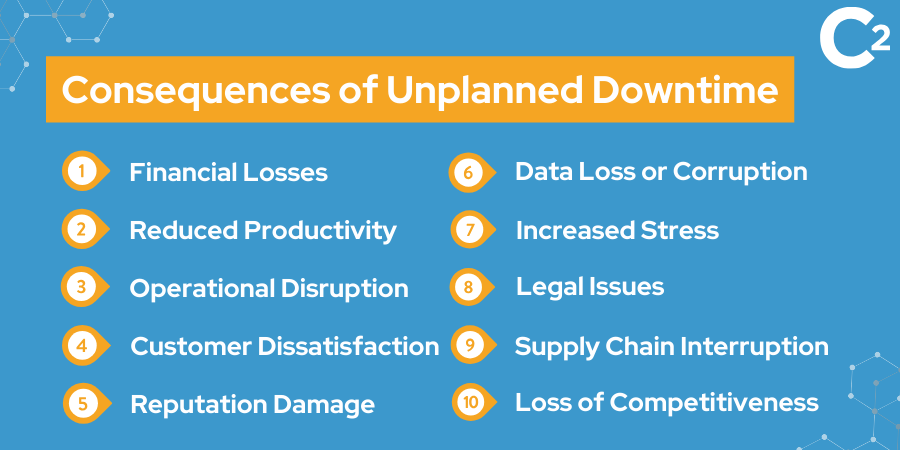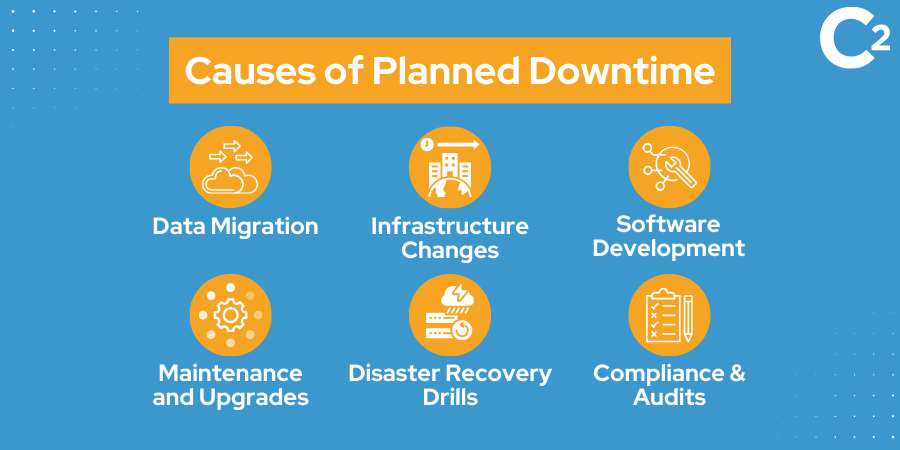Prepare for Planned and Unplanned Downtime
Published on October 14, 2021
Last updated on July 18, 2024
Jump to a section
One of the most frustrating parts of running a business is dealing with downtime. Whether it's planned or unplanned downtime, many businesses are unsure of the best way to handle these situations. As a result, your organisation can suffer from poor communication with customers, staff spending long hours taking care of machines, dealing with network outages, and performing general system maintenance.
When critical failures start piling up, or the date of your scheduled planned downtime draws closer, the most important thing is to keep your composure and act according to your plan. If you make some much needed preparations before the downtime occurs, you will have a much easier time surviving this challenging period and avoiding costly mistakes. Let's breakdown some key elements you should consider
What is Unplanned Downtime?
Unplanned downtime is when your organisations services or operations unexpectedly halt due to issues like equipment failures, software glitches, or external disruptions. Unplanned downtime can lead to significant losses in your productivity and revenue. Often requiring immediate fixes to minimise the impact your business suffers. Some unplanned downtime causes are unavoidable, such as the Covid-19 outbreak. However, others can be predicted such as reducing unplanned downtime with predictive maintenance. Being able to predict equipment failures before they happen will reduce unplanned downtime, reducing your unexpected disruption costs.
The Difference Between Unplanned and Planned Downtime
Planned downtime is when organisations seize production and focus on installing software upgrades, inspecting the machines, and other maintenance related tasks. For example, a company can decide to commit a few hours every month strictly for testing the tools used by its employees, such as communication systems and the internet network. The primary aim of this process is to prevent equipment failure and other complications from happening in the future.
Unplanned downtime, on the other hand, has nothing to do with scheduled maintenance. Instead, it's an inability to provide services because of events outside your organisation's control. An example of this situation would be losing connection with your server due to an unexpected power outage. Unplanned downtime is sudden, unexpected, and can significantly harm the performance of any organisation.
The Consequences of Unplanned Downtime
Unplanned downtime can have a variety of negative consequences across different aspects of your business. Here's a list highlighting the potential consequences your business could experience:
- Financial Losses
- Reduced Productivity
- Operational Disruption
- Customer Dissatisfaction
- Reputation Damage
- Data Loss or Corruption
- Increased Stress and Workload
- Legal and Compliance Issues
- Supply Chain Interruption
- Loss of Competitive Advantage

What Could Cause Unplanned Downtime?
Unplanned downtime events can impact your direct and indirect costs, because your equipment reliability and equipment performance is impacted as a result of equipment failures. Which can then lead to production schedules needing changed and potentially prolonged downtime. Making your downtime costs and other direct costs increase drastically.
- Hardware Failures: Unexpected breakdowns of physical components like servers, hard drives, or networking equipment in your business.
- Software Bugs or Failures: Unforeseen glitches, crashes, or incompatibilities in software that cause systems to go offline.
- Cyber Attacks: Security breaches such as cyber attacks, DDoS attacks, malware, or ransomware infections that disrupt normal operations, which increases costs and threatens promised delivery in your business.
- Power Outages: Loss of electrical power due to external factors like severe weather, accidents, or grid failures.
- Human Errors: Mistakes made by your employees, such as incorrect configurations, accidental deletions, or improper handling of equipment, leading to system and equipment failures.
- Natural Disasters: Events like earthquakes, floods, fires, or hurricanes that damage infrastructure and cause unexpected equipment failure and machine failure in your business. Leading to lost productivity and the need for downtime.
- Network Issues: Problems with internet connectivity or internal networking that disrupt communication and access to critical assets and systems.

FRACAS Method for Unplanned Downtime
Failure Reporting, Analysis, and Corrective Action System or better known as FRACAS is a proactive approach to managing unplanned downtime. This method works by collecting data relating to equipment failures and analysing it, discovering the source of failures. Allowing you to take action and implement solutions. The point of FRACAS isn't to only decrease unplanned downtime but also to increase your equipments efficiency and reliability.
Reasons for Planned Downtime?
The main reason for planned downtime events is to reduce unplanned downtime and unplanned downtime costs. Implementing routine machine maintenance and a proactive maintenance program within a scheduled downtime is one of a few actionable ways to plan your downtime.
- Maintenance and Upgrades: Regular maintenance and updates to software, hardware, or systems to boost your business performance and security.
- Infrastructure Changes: Modifications or upgrades to physical infrastructure, such as data centers, to enhance the capacity or efficiency of your business.
- Software Deployment: Implementation of new software solutions or significant updates to your existing applications, which may require your systems to reboot or downtime to deploy.
- Data Migration: Transferring data from one storage device to another or from one format to another, often needing downtime to guarantee data integrity.
- Testing and Disaster Recovery Drills: Conducting planned tests of systems and backup procedures ensures they function correctly in case of an actual disaster.
- Compliance and Audits: Performing necessary system audits and compliance checks for your business may require your systems to be offline to access and evaluate secure or sensitive components.

Using Machine Data to Reduce Unplanned Downtime
When looking to reduce unplanned downtime using your machines data, there are a couple steps you can take:
- First, equip your machines with sensors to collect real time data. Next, monitor your data inputs and search for any anomalies.
- After this, using predictive analytics you can begin to forecast failures and schedule proactive maintenance.
- Analysing historical data can allow you to discover the root causes of unplanned downtime and provide insights into your machine equipment health.
- Taking action and snuffing out the source of your unplanned downtime is now made easy with your new data bank. Which also allows you to optimise your operations across the business.
- The point of this method is you take a proactive stance instead of a reactive one against unplanned downtime.
Condition Monitoring Techniques to Combat Unplanned Downtime
Condition monitoring techniques help prevent unplanned downtime by tracking your equipment health. Key methods used for doing this include:
1. Vibration Analysis : Detects imbalances and wear in rotating machinery.
2. Thermal Imaging: Identifies overheating and electrical faults through heat patterns.
3. Acoustic Emission: Captures ultrasonic sounds from cracks or leaks.
4. Oil Analysis: Assesses machinery oil for wear debris and contaminants.
5. Motor Current Analysis: Analyzes motor electrical characteristics to spot faults.
6. Performance Monitoring: Monitors operational metrics like pressure and flow to detect degradation.

Prioritise Your Assets
Whether you want to prepare for planned or unplanned downtime, one of the critical steps you should take is to create a list of your assets and sort them from the most to less important ones. This way, you will know which resources you have to address in the first place during downtime.
For instance, if you deem team management software the central asset of your company, you should prioritise getting it up and running as soon as possible. It is especially crucial during unplanned downtime, which can be caused by various factors, including machine jams, weather conditions, human error, etc. In such circumstances, you should know which operations you have to manage first to keep productivity at a satisfactory level.
Implement Standard Operating Procedures (SOPs)
Standard operating procedures are the backbone of every successful support system. They exist for one primary reason to ensure everyone on the team knows what to do at any time. As such, they are a major help in case of downtime. The subjects they may cover are plenty, from performing hardware maintenance to dealing with unexpected delays and lost data.
Before scheduling planned downtime, you should outline every operation your employees need to perform during this time in SOPs. Doing this will minimise the period of stopped production. Besides, it will maximise the benefits and lower the scheduled maintenance costs in the process.
Identify Your Problem Areas
It might not be breaking news for you, but many entrepreneurs forget that every business has a unique structure and flaws. As a result of these flaws, while some organisations could have difficulties making their work environment more welcoming, others might find challenges such as handling power outages and implementing new solutions much more threatening to their survival.
To not let your organisation drown in unnecessary downtime costs, you should identify your problem areas and address them in a planned and organised manner. Take a look at every service and product your company provides and assess its maintenance costs, how its absence can impact the production, and how quick you can get it back to its regular state following an outage.
Thanks to this method, whether you planned your downtime beforehand or not, you will know which services and systems will require more work than others to get them back on the schedule. Moreover, the cost of the whole operation will be significantly lower, as you will be aware of the problem way before it appears.
How to Find Out How Expensive Your Downtime Will be?
Discovering the cost of downtime is crucial for any business, as it shapes your approach to both planned and unplanned downtime. By assessing potential losses and understanding the impact on operations, you can craft a resilient strategy that minimises financial hits and maintains productivity, ensuring you're prepared for when the unexpected occurs.
Calculate the average hourly wage of your employees
One of the first steps you should take when analysing how expensive a downtime event will be for your company. Take into account employee wages and also their output in comparison. As an example, if your employees make you 5x their hourly wage in production. Then add both their hourly wage and 5x their hourly wage as a gage/start. Although there are many other variables such as production costs and maintenance/repair costs, your employee hourly wage is a good area to begin with.
Different Downtime Approaches
Your downtime scenario will require you to use different approaches. To be effective, you might require a mix of proactive and reactive strategies. For planned downtime, focus on scheduling during low activity periods for your business and communicating with stakeholders in advance.
In contrast, for unplanned interruptions, rapid response teams and robust backup systems are key to swift recovery and maintaining continuity. Which is why it's so important to have a versatile approach for different downtime scenarios.

Reactive Approach
A reactive approach swiftly tackles unforeseen disruptions, focusing on quick fixes to restore operations and minimise impact. Most business owners take a reactive approach when downtime events happen. Using this approach allows you to respond to issues as soon as they happen and instantly curb any small problems before your entire organisation is impacted.
Planned Approach
Having a planned downtime event will allow your business to keep systems, tools, processes, and equipment in tip top shape for the entire year. By planning your downtime, you will decrease your chances on an unplanned downtime drastically. Which in the long term saves you money and time. To use this approach, dedicate periods of downtime monthly to ensure your business is running at 100% outside of planned downtime.
Predictive Approach
Investigating and delving into your businesses data and analytics is a fantastic strategy your business can use. Being able to anticipate downtime in your business and when downtime will be costly allows you to prepare and make preventive maintenance to your business. You can do this by gathering and analysing historical performance and maintenance data. Also, using real time monitoring tools to track your systems health and predictive analytics to forecast potential issues.
Use Previous Planned and Unplanned Downtime Data to Your Advantage
If your business has experienced any planned or unplanned downtime, you can use the scenario and results as data for your next planned downtime and predictive approaches. Looking at your past experiences, you can identify patterns and pinpoint your weaknesses. As a side note, you don't need to only analyse your business. If there was an unplanned downtime for a larger, industry leader, use the data presented in news articles and blogs. Use this data to look into how your business would deal with the same unplanned downtime. Remember, in order to gain process improvement you need to also analyse real time data, combining these steps together is how you can build effective preventive maintenance and deal with both planned and unplanned manufacturing downtime.
The Bottom Line
No matter in which industry you operate, sooner or later, you will have to schedule planned downtime or become a victim of a sudden event that will force you to cease operations and address the issue. In situations like these, it is crucial to keep calm and proceed according to the plan.
You can get your business ready for unplanned and planned downtime by learning the difference between them and estimating what service or data is your company's most precious asset. Additionally, you might want to create helpful SOPs and identify your problem areas.
If you follow the steps we mentioned, every downtime you schedule will become much less of a challenge. Similarly, sudden events like power outages will not be as much of a threat to your organisation.
Written by Aimee Quinn
Resilience Manager at Continuity2
With an Honours degree in Risk Management from Glasgow Caledonian University and 6+ years in Business Risk and Resilience, Aimee looks after the design and implementation of Business Continuity Management Systems (BCMS) across all clients. From carrying out successful software deployments to achieving ISO 22301, Aimee helps make companies more resilient and their lives easier in the long run.


Written by Aimee Quinn
Resilience Manager at Continuity2
With an Honours degree in Risk Management from Glasgow Caledonian University and 6+ years in Business Risk and Resilience, Aimee looks after the design and implementation of Business Continuity Management Systems (BCMS) across all clients. From carrying out successful software deployments to achieving ISO 22301, Aimee helps make companies more resilient and their lives easier in the long run.